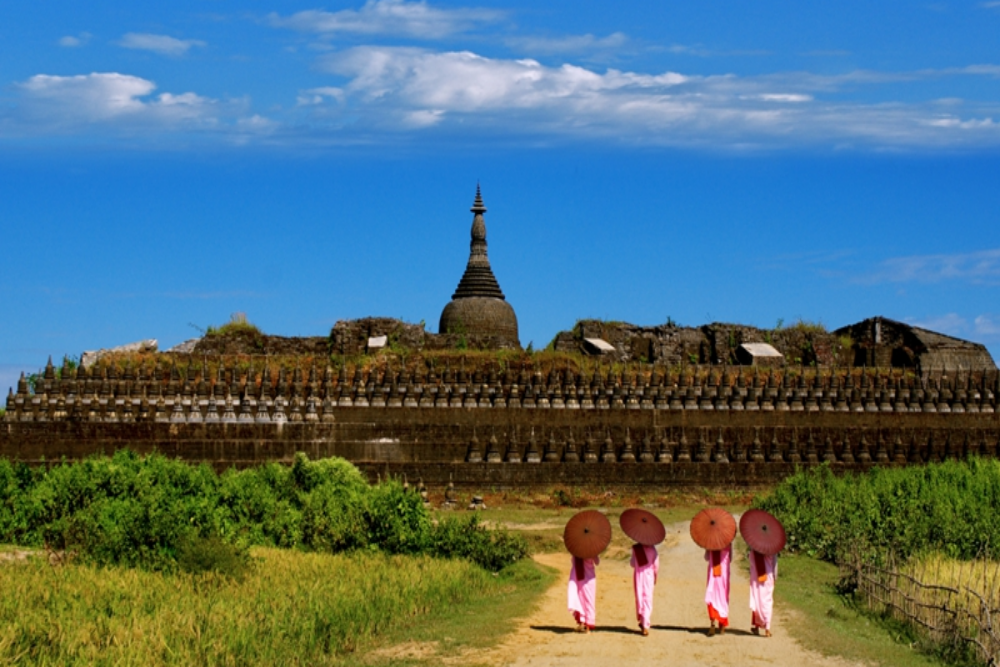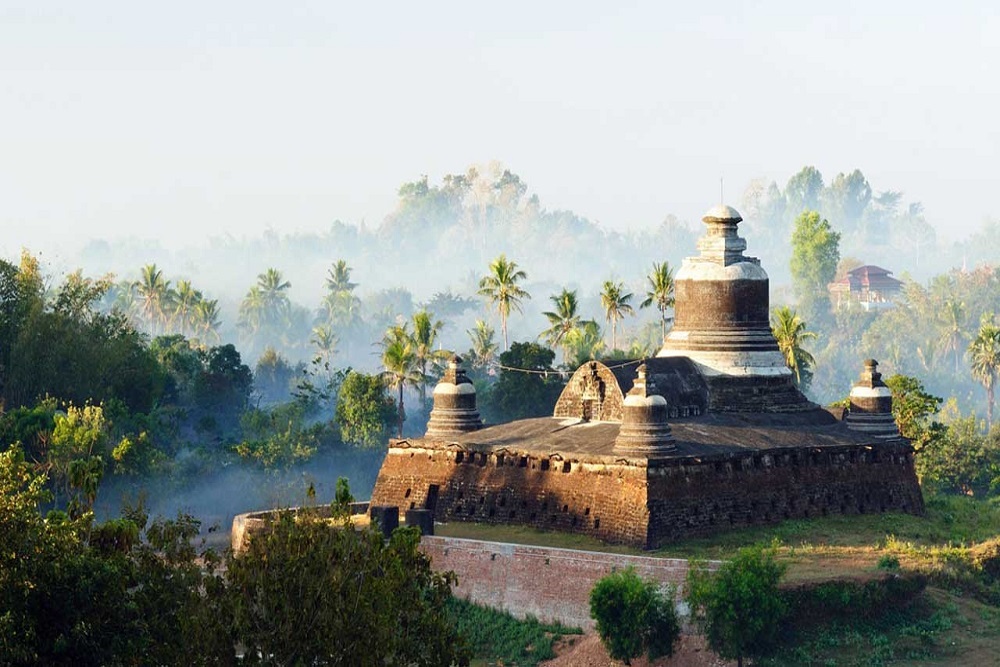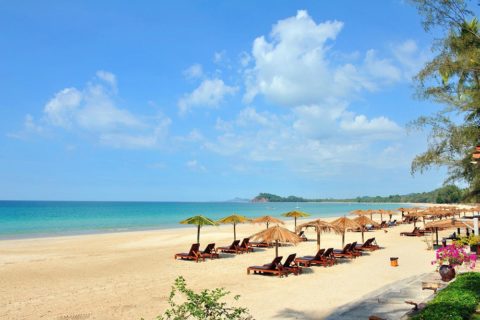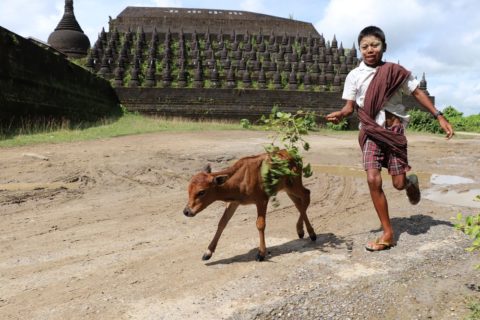About Mrauk U
One of Myanmar’s significant archaeological sites, Mrauk U mesmerizes with over 700 temple ruins that rise gently from lush tropical hills. The charm of the ruins is how alive they seem, tucked between misty streams, rolling countryside and pastoral villages. Farmers and goat shepherds accept the ruins as a part of the land, incorporating the crumbling temples among their vegetable gardens with ease.
Due to the relative isolation of the town from the main tourist trail, Mrauk U still offers visitors a rarified experience filled with awe inspiring views, grand temples and fantastic history in virtual seclusion.
Mrauk U has a fascinating history. During its heyday, between 15th – 18th centuries, the ancient Kingdom of Arakan controlled a large landmass covering modern day Rakhine State and half of Bangladesh. In 1431, Mrauk U was declared the capital of the kingdom. The city was strategically located between India and South East Asia and its proximity to the Bay of Bengal made it an ideal location for a regional trade hub. As the city grew, stunning pagodas and temples were built throughout the surrounding hills. Subsequent rulers would each build their own grand temples and sometimes even build upon existing structures to make their own mark on the kingdom.
Over time, Mrauk U became greatly wealthy as a major trading port with the rest of Asia, the Middle East and Europe. It came to represent a crossroads of trading routes and different cultures from East and West. Foreign merchants from far flung nations like Portugal and the Netherlands would rub shoulders with Arakanese Princess & Princesses.
By the 17thth century, Mrauk U had become famed in Europe as a city of oriental splendor and wealth. Written accounts, by European visitors, describing the magnificence of the city and the extravagance of the Arakan Royals fueled Western interest in the city. The Dutch traveler Gautier Schouten, who visited the city in 1660, observed that Mrauk U was comparable in size and wealth to other grand western cities like London and Amsterdam. He described the city as having one of the richest ports in Asia, and offered a vivid account of its visual wonders. An excerpt from his writings follows:
Over time, the rulers of Mrauk U became significantly more concerned with the protection of their fantastically wealthy city. Walls and forts were built along the high ridges and hills surrounding Mrauk U. Some of the main pagodas were designed to also serve as defensive fortresses. An extensive chain of canals and moats were dug up to provide fresh water and a measure of defense. A vast naval fleet of 10,000 boats fitted with modern canons was built to protect the kingdoms coast lines. Foreign soldiers and mercenaries from Europe and the Middle East were recruited into the Kingdoms army. A group of Samurai from Japan even served as royal body guards.
Their efforts were successful and Mrauk U was able to protect itself from foreign invaders for centuries to come. However, in the 18th Century, the kingdoms reign finally came to an end when the city was conquered by the forces of the Burmese Konbaung Dynasty. But its status as a major trading port was not lost until the 19th Century, when the British colonized Burma and designated Sittwe, a coastal town 70km west of Mrauk U, as the new commercial hub of the Arakan region.
Over the course the 19th and 20th Centuries, Mrauk U went into decline and eventually faded into a quiet back water. Its glorious palaces and halls crumbled and vanished until all that remained of the Arakan Kingdom were its vast complexes of pagodas and temples, structures built with almost everlasting sandstone. The lands of the once mighty Arakan kings were eventually settled by farmers and small village communities.
The town of Mrauk U is centered around the remains of the old royal palace. The original palace constructions are long gone but the stone foundations remain and offer an idea of how the palace grounds were laid out. Just inside the palaces western entrance is the worthwhile Palace Museum. Run by the Department of Archeology, the museum features an interesting collection of excavated Buddha images and artifacts from the times of the Arakan Kingdom. The central market is located to the west of the palace and offers ample opportunities to witness local Rakhine life, especially in the early hours of the day. Most hotels can be found in the vicinity of the palace grounds.
The main sights of Mrauk U are often split into geographic groupings. The Northern group offers the greatest concentration of attractions including some of the most significant temples in the area. This group is in short walking distance from the center of town and the palace grounds.
Here you will find Mrauk Us most famous sight, the Shittaung Pagoda. Built in 1535 to celebrate Arakanese King Min Bins victory over the provinces of Bengal. The interior of the pagoda offers a mesmerizing labyrinth of hallways filled with stone Buddha images, colorful Arakanese characters and elaborate artwork. Just north east of Shittaung Pagoda are the Andaw Temple and Ratanabon Zedi. The Andaw temple features a circular vault filled with large stone Buddhas and is said to enshrine a tooth relic of the Buddha. The Ratanabon Zedi, built in 1612, is an impressive example of classic Arakanese Stupa design, a large bell shaped structure built with dark brick, unique to the region.
Opposite Shittaung Pagoda, is the striking fortress-like Htukkanthein Temple. Built in 1571, this imposing temple served a dual purpose as a fortress and is set on high ground featuring a militaristic design, with small windows and only one entrance. Its interior chamber spirals clockwise from the entrance towards the Buddha statue contained in the central dome. The hallways are aligned with hundreds of stone figures depicting male and female characters wearing traditional Arakanese outfits. There are also several hills in the surrounding area that make for perfect sunrise or sunset viewing and the opportunity to capture photographs of the iconic temples in different lighting.
In the Eastern group, the attractions are spread over a larger area and it is recommended to explore this section either by car or bike. The most famous temple in this group is the majestic Kothaung Temple, the largest structure in Mrauk U. Built in 1553, this colossal temple is said to contain 90,000 Buddha images. Regardless of the true number, the sheer amount still standing in varying conditions throughout the structure make for a remarkable visit. Once you climb the stairs at the entrance of the temple, you can circle the central stupa through two outer hallways. The vaulted bottom hallway features stunning carvings and Buddha images and makes for a very atmospheric and otherworldly experience.
A short walk from Kothaung Temple you will find the noteworthy hilltop monument of Pizi Phara. This crumbling structure has a circular enclosure with four intricately designed Buddha statues each facing in the directions of the compass and one statue at its summit. The hilltop also offers great views of surrounding countryside.
In the Southern Group you will find the Shwe Taung Pagoda, built on one of highest hilltops in Mrauk U and an ideal spot for sunrise viewing. Another notable mention is the Zinamanaung Pagoda, a beautiful hilltop structure offering panoramic views of the surroundings. Nearby are the remains of the Lattsaykan gate, one of the old Kingdoms main gates and a reminder of the cities once imposing defensive measures. Another worthwhile place to visit is Bandoola Kyaung a sprawling monastery set over several hilltops and said to hold a Buddha tooth relic. It also an ideal spot to witness the lives of the local monks.
A visit to the remote Chin ethnic minority villages upriver from Mrauk U makes for a fascinating day trip. Chin woman are known for their distinctive tattooed faces, an old tribal tradition that was believed to have protect them from being taken as wives by other tribes during times of conflict. To reach the villages, you will first travel by car thirty minutes east to reach the Lay Myo river where you board a small boat to embark on a scenic journey upriver. The journey time is approximately 3 hours one way. At the villages you will have the opportunity to observe firsthand the local traditions and life styles of the Chin people and meet some of the famed tattooed ladies. Such tours can be booked through hotels or agencies throughout Mrauk U, but beware of the tendency for agents to initially quote prices with huge markups.
To reach Mrauk U most visitors opt to first fly to the town of Sittwe, the capital of Rakhine State. Several airlines fly from Yangon to Sittwe daily. Direct flights take approximately 50 minutes and flights travelling via Thandwe (gateway to Ngapali beach) take approximately one hour and twenty minutes. Myanmar Airlines offers seven daily flights, four of them direct. Other airlines offering the route include Golden Myanmar, Yadanarpon Airlines, Air KBZ and FMI Air. Prices start from about 95 USD one way for foreigners.
From Sittwe, Mrauk U can be reached by either boat or car. Taking a boat is the recommended option, as it makes for a memorable journey travelling up the Kaladan River, drifting by sleepy villages and picturesque countryside. You can choose from both a public ferry or a private boat charter to make the journey. Public ferries run every morning at 7am and cost 10USD for foreigners. The journey time is approximately 5 hours. The ferries tend to be quiet old and rusty but there have been no reports of major incidents. Travelling aboard one makes for a great opportunity to travel at a lazy pace, soak in the landscape of the Rakhine backwaters and even mingle with locals onboard.
The other option is a private boat hire. Prices for private hires vary significantly but rates of 20 USD per person for a group of 4-6 on a one way journey are reasonable. Several touts in Sittwe as well as at the airport, will approach you offering charter boat hires but be wary of booking a spot before inspecting the vessel yourself. The advantage of a charter boat hire is that you may leave when it’s suitable for your group and therefore you will not have to spend a night in Sittwe to catch the morning ferry.
Mrauk U can also be reached by bus or private car hire from Sittwe, the journey time is about 3.5 hours by bus or 2.5-3 hours by car. However, the roads are in very poor condition and the journey does not make for much of a noteworthy experience.
Truly hardy travelers may consider travelling to Mrauk U by bus from Mandalay or Yangon. Restrictions on land travel for foreigners have been lifted recently and road access has improved but the journey is still very arduous and not for the faint hearted. From both Yangon and Mandalay, the journey takes approximately 18 hours and significant portion of the time is spent travelling across the windy high altitude roads of the Arakan mountain range. Prices for tickets start from 18 USD.
Once in Mrauk U, you can either choose to walk, rent bicycles or hire a car/jeep. Depending on the location of your hotel, the Northern group of temples may be in easy walking distance from your accommodation. For pagodas and temples further afar in the Eastern and Southern Group, fit and adventurous visitors may consider riding bikes, but take into consideration the searing midday heat and prepare yourself accordingly. Hiring a private car or jeep for day costs approximately 40 USD. Most of the roads leading to the more remote temples are however in poor condition and very bumpy and so a jeep would be the recommended choice.
Once your time in Mrauk U comes to an end, there are few options for where to continue next. Most travelers opt to take the ferry back to Sittwe and fly to Yangon. Public ferries from Mrauk U to Sittwe depart daily at 7am. There are afternoon flights available back to Yangon and so if you time your schedule right you will not have to spend an extra night in Sittwe.
With land travel restrictions lifted for foreign travelers and road conditions gradually improving, continuing your journey by bus is another option. From Mrauk U, buses depart daily to Yangon, Mandalay, Pyay, Bagan (via Kyauk Padaung) and Thandwe (Ngapali Beach). However the journeys are still long and arduous and definitely not recommended for the faint hearted.
DESTINATIONS IN WEST MYANMAR
Ngapali Beach
Pathein
Nagaland
Sittwe
Ngwe Saung
Chin State
CHECK OUT OUR
MRAUK U TOURS
MRAUK U AND LAY MRO CHIN VILLAGES
Dutch traveler Gautier Schouten who visited Arakan 1660 wrote: “As we ascended sufficiently high up the mountain we could decry the city of Arakan and the golden roof of the palace, which...
AMAZING MYANMAR
Amazing Myanmar tour is a a perfect combination of culture and relaxation. Explore the big 4 and chill on the beach before heading back to Yangon and home....
KINGDOMS OF MYANMAR & NGAPALI BEACH 14D
Full of culture and interesting history, this tour will show you the best of Myanmar at close range. From the highlights of Bagan and Inle Lake to the remote ancient Kingdom of Mrauk U, this tour...
MRAUK U & NGAPALI BEACH
This guided tour will take in the best of Western Myanmar, from the lost city of Mrauk U to the beautiful resort of Ngapali Beach....
OTHER REGIONS
Myanmar / Essential Information
- Visas and border crossings
- Country facts and figures
- Language and culture
- Security
- Money
- Mobiles and the Internet
- Travel to and around Myanmar
- And more








